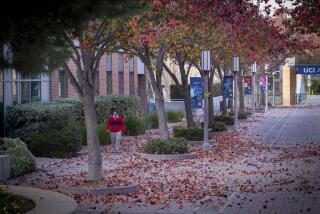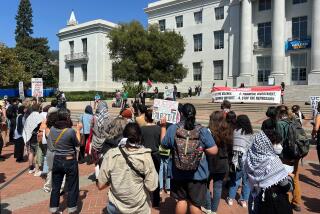Regents Will Ask Selves: Why Is UC In Nuclear Arms Business?
The University of California is a big name in the education business, each year turning out thousands of graduates from nine campuses around the state.
It is also big in the nuclear weapons business, contributing over the years such innovations as the hydrogen bomb, the neutron bomb, the MX missile and the cruise missile.
In 1942, UC Berkeley physicist J. Robert Oppenheimer was named to lead America’s race against Nazi Germany to build the first atomic bomb, and ever since then the university has managed the development of the nation’s nuclear arsenal.
The nation’s two nuclear weapons laboratories--at Livermore, Calif., and Los Alamos, N.M.--are run by the university under contract with the U.S. Department of Energy, a contract that must be renewed by the UC Board of Regents later this month.
This upcoming decision has revived an enduring question for the regents: Why is the university in the business of creating new nuclear weapons?
Faculty critics say the university should sever its ties with the labs because Livermore and Los Alamos, far from being research centers, are a driving force in the nuclear arms race.
They also charge that the university’s management is, in the words of former Gov. Edmund G. Brown Jr., “a sham.”
“The labs are the patrons, the supporters, the advancers of the arms race,” said Charles Schwartz, a UC Berkeley physics professor. “They sold the neutron bomb to the Pentagon in the early 1970s, they sabotaged the comprehensive test ban treaty and they were busy selling ‘Star Wars’ to Reagan and the public.”
He said the university allows the labs “to carry the cloak of academic impartiality” when in fact they are pushing particular products--in this case, nuclear weapons.
Over the last 20 years, UC faculty committees have examined the labs and generally supported continued university management. In the most recent vote on the question, 380 professors on the Berkeley campus voted last spring to retain the university’s ties, while 357 voted against them.
But while the faculty has consistently--and narrowly--approved those ties, the professors have also criticized the university’s administrators for failing to assert control over the labs.
“Every major review of this relationship has concluded that stronger university oversight is essential to a continuation of the contract, but it’s never happened,” said John Holdren, a professor of energy and resources at UC Berkeley.
Washington decides what weapons will be built, he said, and the labs decide how to build them. “The university doesn’t manage at all. It just gives the erroneous impression that there is some oversight and control,” Holdren said.
The regents will hold a public hearing today in San Francisco on the proposed five-year renewal of the lab contract. They will vote on the renewal Sept. 20 at UCLA.
The Lawrence Livermore National Laboratory, a mile-square, fenced-off facility 35 miles east of Oakland, has 8,000 employees. Managers and researchers say the lab is close enough to the San Francisco Bay Area to benefit from a scientific interchange with the Berkeley faculty. It is also close enough to be an occasional setting for anti-nuclear demonstrations.
The Los Alamos National Laboratory, in a remote site 30 miles north of Santa Fe, built the first atomic bomb in 1945 and today competes against Livermore for the design and development of new weapons. It employs 7,900 people, who, like their Livermore counterparts, officially work for the University of California.
A third major lab, the Lawrence Berkeley Laboratory, sits on a hill above the campus, but it is not involved in weapons work.
A once-forceful critic of the UC role in the weapons labs will not be part of the debate this time. In 1980, then-Gov. Brown led the fight to sever UC’s ties with the labs, charging that the university is “basically a cover and an insulating mechanism so that the labs can do pretty much what they want.”
“I don’t think this board (of regents), which is competent to handle campus parking tickets and housing questions, has the wisdom, the time, the temperament or the inclination necessary to resolve this most serious business,” Brown told his fellow board members before the 1980 vote.
That statement was not particularly well-received, and the regents, many of them Brown appointees, voted 15 to 5 to go ahead with the contract.
University officials think the vote will be similar this year.
“I doubt if there will be more than five or six votes against it” on the 28-member board, said Jeremiah Hallisey, a regent from San Francisco and a vice chairman of the committee that oversees the labs.
UC officials privately describe the weapons labs as something of a headache, but they say the relationship is one they will seek to continue because of the tradition dating to the Manhattan Project, the World War II effort that produced the first atomic bomb.
“I think when you add up all the arguments pro and con, it comes down to a public service,” said James Kane, a former Energy Department official who is the UC liaison with the labs. “As long as Congress votes for nuclear weapons, they are going to be with us. And I think the citizens benefit from having the university manage the operation.”
Because the university is the manager, dissenting opinions and skepticism are tolerated at Livermore and Los Alamos, according to Kane and other supporters of UC’s management. If the regents were to end the contract, it would probably shift to one or several private corporations, they say.
“The public has to decide whether they would rather have the university and a politically diverse board of regents involved in this (management of the labs); or would they prefer Union Carbide do it?” Hallisey asked.
UC officials do not claim to do much managing, although they say they now exercise more oversight than in the past.
“It’s true. We don’t do a lot of managing. You give a lot of discretion to the lab directors,” said Kane, the UC liaison. “We can’t get into the technical questions. But we do appoint the director, and we have oversight committees that nose around in areas like health and safety.”
UC and lab officials also discount the charge that the scientists and lab managers drive the arms race. The President, Congress and the Pentagon can make weapons decisions on their own, they say. Moreover, they note, a lab run by a private corporation would be even more likely to push its own products.
Though Edward Teller, the aging “father” of the hydrogen bomb and a driving force behind the creation of the Livermore lab, has been widely credited with selling President Reagan on the possibility of a nuclear defense system, university officials note that the labs also contain a number of well-known, in-house skeptics who regularly cast doubt on the entire concept.
“You can speak out critically within the fence, so to speak, and say the President’s idea is not practical and feasible without being in danger of losing your job,” said Norris Smith, a Livermore spokesman.
He and other lab officials also disputed the public notion that the labs are interested only in building more and bigger bombs.
“We’re actually building smaller, safe, more tamper-proof nuclear weapons,” said Smith, noting that, according to Defense Department data, the number and size of the nuclear weapons in the U.S. stockpile have shrunk considerably since 1965.
More to Read
Sign up for Essential California
The most important California stories and recommendations in your inbox every morning.
You may occasionally receive promotional content from the Los Angeles Times.










